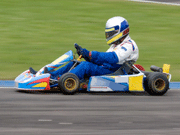
Kart

Karting began with the first kart designed by Art Ingels in 1956 and has since technically evolved its basic racing technology. It is the simplest and lowest cost form of road and oval racing available but even so, the racing kart can out-compete many race cars costing 5 to 10 times as much. It is the launch pad for almost any child interested in racing (along with ¼ midget for the dirt trackers and junior dragster for the drag racers).
The kart has a tube frame, to which is mounted a 1-piece axle, hubs, wheels/tires, steering, seat, fuel tank, engine, drive sprocket, and brake. Most karts use a centrifugal clutch, although some have gearboxes (Called Shifter karts). Bodywork also varies from minimal bumpers on sprint karts to full cover bodywork on ovals or superkarts.
There is usually no suspension and no differential on a kart because the design bypasses the need for these. The flex in the tube frame and tires absorbs the bumps encountered and the kart uses a special front-end geometry that causes the inside rear wheel to lift slightly when turning corners (So there is no need for the rear wheels to turn at different speeds)
Racing is generally held on purpose-built kart tracks that are around 1 km (0.6 miles) or on short oval tracks. Kart racing is run everywhere in the world, but is especially popular in Europe.
| Power and Weight Stats | |
| Horsepower (Typical Range) | 5-90 |
| Race Weight (Typical Range) | 136-204 kg 300-450 lb |
Design and Construction
Race Car Models of This Type
Sprint, Oval, Superkart
Build Your Own Kart
Knowledge Level
If you are interested in building a new and better kart then scratch building will be the way to go. If you are interested in building an existing design then there are pre-fabricated kart chassis available that only require the purchase of the attached components and assembly.
If you are scratch building a new design, you should be knowledgeable in handling, chassis, powertrain, and safety design as far as it relates to a non-suspension kart-type chassis. It is easy to underestimate the skill required to build a custom racing machine, and the "Suspensionless" kart chassis is no exception. A working knowledge of vehicle handling, tube chassis design, powertrain and safety considerations will leave you far more confident in your design than a trial-and-error approach.
Design Challenges
Weight Distribution: Having a good static weight distribution is important, and with karts this generally looks like 35% Front/65% Rear. Positioning of the seat laterally can help to find as close to 50% left/50% right as possible as well.
For racing purposes, the lower the seating position the better within the regulations. Going any lower than the bottom of the chassis tubing, however, opens up the possibility of the seat contacting the track.
Suspension: The kart has no suspension and instead relies upon flex in the chassis and upon front wheel geometry that causes the chassis to "tricycle" around corners by lifting the inside rear wheel. For maximum cornering ability, a wider track width is better. In the wet, the opposite is true: the narrower track helps transfer more weight to the outside tires for better grip .
Chassis: The chassis does not need to be absolutely rigid, and in fact benefits from some flex. Usually there is a need for basic cross-bracing to ensure the chassis/frame remains straight (i.e. When viewed from above). When viewed from the side, the frame will bend slightly when the wheels go over a bump.
Powertrain: Alignment of the engine and drive sprocket is important, as is the clearances around and accessibility of the brake caliper and master cylinder. When designing, consider changing brake fluid, bleeding accessibility. If racing on dirt, you may wish to consider bearings with dust shields.
Safety: Consideration should be given to securing critical fasteners with castellated nuts and safety wire to prevent failures of brakes, loss of wheels, or drivetrain components. This is good practice on any race car.
If you intend to race under a sanctioning body, always read and understand the regulations of your chosen racing class before designing or building any race vehicle.
Design Resources
Learn the basics about race cars and race car design from our free online knowledge series
Download our free race car design aids to assist you designing your race vehicle.
In-depth books and learning resources we recommend for kart design.
Join our forum to ask and find answers to your kart design/construction questions.
Construction Challenges
To ensure the correct front wheel geometry, use a jig to hold pieces at the correct angles for welding or brazing. Use of a solid, flat and level build space is also important.
Having sufficient space for the build is important, as a cramped workshop can be difficult to work in.
The tools to fabricate the chassis (ie. welder, metal working) can add considerably to the cost of your project if you don't already have a workshop, but borrowing or renting items is also an option.
Build Costs
All components are available off-the-shelf, so the cost is generally the lowest of any type of racing machine.
Build Effort
If the kart is scratch-built, there will be a significant effort in design and construction, but far less than a race vehicle with suspension or complex chassis and powertrain. If building from a pre-fabricated kit, the effort will be far less and focused on assembly.
Racing Cost
Racing costs are low, with the greatest costs coming in tires and engine rebuilds.
Transportation and Support Equipment
Can be loaded into the back of a pickup truck or onto a small trailer. Support equipment can be carried in the transport vehicle.

